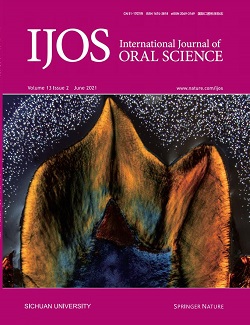骨调节素通过白细胞介素-1受体1/核因子-κB信号通路调节牙髓炎的炎症反应。
IF 12.2
1区 医学
Q1 DENTISTRY, ORAL SURGERY & MEDICINE
引用次数: 0
摘要
牙髓炎是临床上常见的口腔感染性疾病。牙髓炎免疫防御的调节机制仍在研究中。骨调节素(OMD)是一种分布在骨骼和牙齿中的富含亮氨酸的小蛋白多糖家族成员。它是一种促进成骨和抑制人牙髓干细胞(hDPSCs)凋亡的生物活性蛋白。本研究探讨了OMD在牙髓炎中的作用及OMD诱导的调控机制。免疫荧光染色法检测正常和炎症人牙髓组织中OMD的表达。有趣的是,在牙髓炎标本的炎症浸润区,OMD表达降低。细胞实验表明重组的人OMD能够抵抗脂多糖(LPS)诱导的炎症的有害影响。建立条件Omd基因敲除小鼠牙髓炎症模型。在条件Omd敲除小鼠中,lps诱导的炎症损伤显著增加,而Omd给予对牙髓炎具有保护作用。机制上,OMD过表达的转录组改变在核因子-κB (NF-κB)信号通路中显著富集。白细胞介素-1受体1 (IL1R1)是激活NF-κB通路的重要膜受体,在omd过表达的hDPSCs中显著下调。此外,利用共免疫沉淀和分子对接验证了OMD与IL1R1之间的相互作用。在体内,使用IL1R拮抗剂可以挽救omd缺陷小鼠过度的牙髓炎症。总体而言,OMD通过IL1R1/NF-κB信号通路在炎症反应中发挥保护作用。OMD可优化hdpsc的免疫调节功能,可用于再生牙髓学。本文章由计算机程序翻译,如有差异,请以英文原文为准。
Osteomodulin modulates the inflammatory responses via the interleukin-1 receptor 1/nuclear factor-κB signaling pathway in dental pulpitis.
Pulpitis is a common infective oral disease in clinical situations. The regulatory mechanisms of immune defense in pulpitis are still being investigated. Osteomodulin (OMD) is a small leucine-rich proteoglycan family member distributed in bones and teeth. It is a bioactive protein that promotes osteogenesis and suppresses the apoptosis of human dental pulp stem cells (hDPSCs). In this study, the role of OMD in pulpitis and the OMD-induced regulatory mechanism were investigated. The OMD expression in normal and inflamed human pulp tissues was detected via immunofluorescence staining. Intriguingly, the OMD expression decreased in the inflammatory infiltration area of pulpitis specimens. The cellular experiments demonstrated that recombined human OMD could resist the detrimental effects of lipopolysaccharide (LPS)-induced inflammation. A conditional Omd knockout mouse model with pulpal inflammation was established. LPS-induced inflammatory impairment significantly increased in conditional Omd knockout mice, whereas OMD administration exhibited a protective effect against pulpitis. Mechanistically, the transcriptome alterations of OMD overexpression showed significant enrichment in the nuclear factor-κB (NF-κB) signaling pathway. Interleukin-1 receptor 1 (IL1R1), a vital membrane receptor activating the NF-κB pathway, was significantly downregulated in OMD-overexpressing hDPSCs. Additionally, the interaction between OMD and IL1R1 was verified using co-immunoprecipitation and molecular docking. In vivo, excessive pulpal inflammation in Omd-deficient mice was rescued using an IL1R antagonist. Overall, OMD played a protective role in the inflammatory response via the IL1R1/NF-κB signaling pathway. OMD may optimize the immunomodulatory functions of hDPSCs and can be used for regenerative endodontics.
求助全文
通过发布文献求助,成功后即可免费获取论文全文。
去求助
来源期刊

International Journal of Oral Science
DENTISTRY, ORAL SURGERY & MEDICINE-
CiteScore
31.80
自引率
1.30%
发文量
53
审稿时长
>12 weeks
期刊介绍:
The International Journal of Oral Science covers various aspects of oral science and interdisciplinary fields, encompassing basic, applied, and clinical research. Topics include, but are not limited to:
Oral microbiology
Oral and maxillofacial oncology
Cariology
Oral inflammation and infection
Dental stem cells and regenerative medicine
Craniofacial surgery
Dental material
Oral biomechanics
Oral, dental, and maxillofacial genetic and developmental diseases
Craniofacial bone research
Craniofacial-related biomaterials
Temporomandibular joint disorder and osteoarthritis
The journal publishes peer-reviewed Articles presenting new research results and Review Articles offering concise summaries of specific areas in oral science.
 求助内容:
求助内容: 应助结果提醒方式:
应助结果提醒方式:


